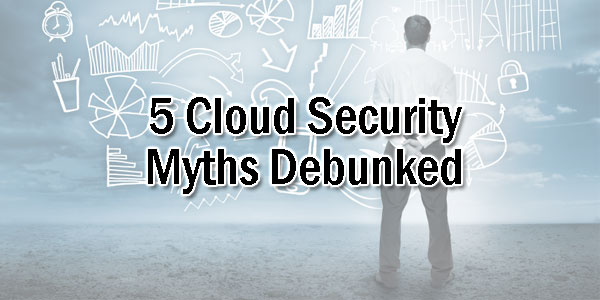
Cloud computing enables its users to store data in third-party storage apps. This great invention gives us the chance to work with our data from any place at any time and that’s one of the reasons it quickly became integral part of our lives and most IT businesses. Cloud computing also enables rapid deployment, provisioning and scaling of data, which all lead to users integrating acquired companies more easily.
Together with the rise of cloud technology, many (mostly irrational) fears for the security of data stored on cloud arose. These made many companies reluctant to move all of their workloads and applications to the cloud. If you think about it, these security concerns are not much different than the initial fear from computers or the Millennial bug. That’s why in this article we decided to debunk five major cloud computing myths and prove that clouds are completely safe environments.
Table of Contents
Cloud Is More Vulnerable To External Threats:
Like any other data storage, clouds can also be subjected to external attacks. Major cloud security threats, identified by the Cloud Security Alliance in 2013 are:
- Data Breaches
- Account Hijacking
- Insecure APIs
- Denial of Service
Basically these are the same threats that come with regular data storage. That’s why there are lots of very efficient defenses that can be used to protect the cloud, some of them are:
- Basic Firewalls
- Vulnerability Scanning
- Network Intrusion Prevention
- Encryption to Network Intrusion Detection
- Multi-factor Access Control and Monitoring
Cloud platforms are not more exposed to external security threats than other data storage, like the ones deployed by hosting provider or company’s own internal IT structure. Therefore, clouds should have the same level of security as any of those platforms, which should include both detection and prevention of external attacks.
Customers Of A Cloud Are A Threat To Each Other:
One of the biggest myths that circle around this great piece of technology is the belief that multi-tenant cloud structures are less secure than the matching IT ones, because it gives customers the opportunity to attack other customers using the same service. In reality, the fact that customers in one cloud share compute, storage and network resources doesn’t make them vulnerable to other customers using the same service. Their accounts are guarded by a few different security measures:
- Hypervisor layer- hypervisors make the primal separations between customers, and they are very difficult to attack.
- Management layer
- VLAN isolation- this is another security measure that’s often done by cloud providers, and it prevents customers from the same provider to gain access to same networks.
Some cloud providers offer additional security options that mitigate the risk that comes with multi-tenant environments.
It’s Hard To Control Where Data Resides Inside The Cloud:
This, like many other things mainly depends on the provider of cloud services. In many countries it is forbidden to export citizen’s personal data, or health and tax information, so providers need to guarantee the data won’t be stored on servers located abroad. This problem can be solved by choosing global footprint providers who offer data accountability. Another very useful tool is a remote access software that becomes more common in cloud computing and that enables users to closely track their data much easier than before.
Clouds Are Not Transparent:
Many cloud users had remarks about transparency. Lack of transparency that will allow easier IT governance was often an issue, but most subscribers don’t know that this issue is not unique for all cloud providers. Not all providers invest money in transparency of their services. That’s why it’s important to choose providers who adopted the Cloud Trust Protocol (CTP). This protocol is meant for providing information to the subscribers and enabling them to confidently choose processes and data and put them in appropriate clouds. It also sustains information risk decisions about the cloud services. That’s why it’s very important to choose the right provider that understands the importance of security and transparency.
Certifications Provide Assurance To Subscribers:
Certifications and regulations are basics for building a trustworthy service, and that’s why they are usually applied to the most vulnerable data processes, that work with financial services, credit cards or health care records. When it comes to cloud computing compliances are no different than the ones in the hosting environment, only difference is that the infrastructure and applications are assembled on a single distributed infrastructure. Clouds come with the same certifications like the traditional IT services. These include:
- SSAE 16 for financial services
- PCI-DSS for credit cards processing
- HIPAA for healthcare records
Although certifications are good reference points, cloud subscribers can’t rely on them when it comes to satisfying all organization’s security and compliance needs. Every subscriber needs to understand the security capabilities of a cloud provider, and have emergency plans for ensuring security of their company’s data, if something goes wrong.


 About the Author:
About the Author:
















Be the first to write a comment.